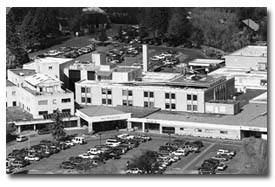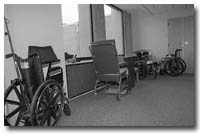|
Pieces beginning to come together for
hospital's expansion
by Will Sands
photos by Ben Eng
 As headlines, moratoriums and perceived threats swirl around the
Southern Ute Indian Tribe’s proposed Grandview development,
one thing has remained a constant – the relocation and expansion
of Mercy Medical Center. And while Grandview appears to be an
opportunity for the hospital, members of its Board of Directors
say it is a necessary move for the strained facility. And the
board stresses that Mercy Medical wants to keep the community
involved in its growth.
As headlines, moratoriums and perceived threats swirl around the
Southern Ute Indian Tribe’s proposed Grandview development,
one thing has remained a constant – the relocation and expansion
of Mercy Medical Center. And while Grandview appears to be an
opportunity for the hospital, members of its Board of Directors
say it is a necessary move for the strained facility. And the
board stresses that Mercy Medical wants to keep the community
involved in its growth.
In early September, the Southern Ute Tribe and Crader family announced
plans to develop 920-acres adjacent to U.S. Highway 160, including
the once-contentious Artesian Valley Ranch (AVR). While the 250
units proposed for AVR in the late 1990s drew intense opposition,
the tribe and Crader’s push for as many as 2,000 new units
in roughly the same place, about two miles east of Durango, has
somehow escaped controversy to date. Like most recent La Plata
County development proposals, the tribe and the Craders have seized
upon the recent new urbanism surge. They have also offered to
donate, with no apparent strings attached, a 35-acre parcel to
Mercy Medical Center, which has consequently made plans to relocate
to Grandview.
In a written statement released last week, Tribal Chairman Leonard
Burch restated the tribe’s commitment to the hospital. “We
have expended thousands of man hours and substantial amounts of
money in order to provide Mercy with the finest possible location
for the hospital that will serve southwestern Colorado for the
next 50 years,” he wrote.
Long overdue
And while Mercy could be perceived
as taking an opportunist leap into Grandview, its current facility
is bursting at the seams. According to Board of Directors Chair
Pat Murphy and Vice-Chair Ellen Roberts, the move is long overdue.
“The hospital has always been there to respond to community
need,” said Murphy. “Because of the market we’re
serving now, we can’t really be responsive to the current
needs of the community.”
Murphy cited lack of parking, a tremendous amount of deferred
maintenance, an undersized intensive care unit that regularly
sends patients to other hospitals, and an inability to accept
new physicians and offer the latest medical services because of
a lack of room. And while Mercy has been hesitant to leave its
current 8-acre location in the heart of Durango next to the Animas
River, the existing facility is beyond help, according to Roberts.
“It would have been wonderful to be able to do what we wanted
at the current site,” she said. “But there comes a
time when a building no longer has renovation potential.”
By comparison, the hospital plans to not simply expand onto the
donated 35-acres but exercise some purchasing options and acquire
a total of 80 acres, 10 times the hospital’s current space.
With a planned 230,000 square feet, a central hospital building
as well as medical campus is envisioned with private practices
surrounding it, as well as cardiology, psychiatric and dialysis
facilities.
“Depending on the services we attract, we can develop into
a regional facility, not because we are striving for that, but
because of the excellence of the project,” Murphy said.
In addition to the land donation, the hospital expansion is also
relying heavily on a $76 million loan from Catholic Health Initiatives.
“Without them, this would have been extremely difficult,”
Murphy said.
Murphy added that while the move appears to take Mercy out of
Durango, the hospital will actually be moving closer to the middle
of its changing service area. “From both a geographic and
demographic standpoint, the growth over the last several years
has moved in that direction,” he said. “Now, the Grandview
site really represents the center of our community.”
A community process
Both Murphy and Roberts emphasized
that community input has been and will
 |
| Mercy Medical Center faces problems
with parking, inadequate facilities, deferred maintenance
and overcrowding, as witnessed by these wheelchairs lining
a hallway. ./Photos by Ben Eng |
continue to be essential to the
process, countering charges that this has been a back-room process.
“I think it’s important that folks realize this is
not an ego trip in terms of anyone’s place in this,”
said Roberts. “This is a community asset, and we have worked
to get community input, and we want more. It’s not like
Big Brother stepped in and said, ‘This looks like a great
place to build a hospital.’”
Murphy concurred, saying that as the hospital moves out of the
conceptual phase, the public will be offered numerous opportunities
to shape its future. “We’ll have a complete community
plan that we’ll roll out to everyone,” he said.
Government agencies and their handling of the Grandview project
will largely dictate the timeline for construction of the hospital.
However, a completion date of 2005 is anticipated. Toward that
end, Mercy Medical Center selected a national architectural firm,
Architectural Nexus, to begin work on the project. Architectural
Nexus has substantial experience designing new hospitals, medical
office buildings, surgical centers, clinics and campus health
science facilities. Murphy and Roberts noted that as drawings
become available, they will be shared with the public.
“I wish we were three years down the road and witnessing
the fruits of everyone’s labor,” concluded Murphy.
“This is a real monumental thing for the community in a
lot of ways. We really think this will be a positive thing and
something the community will be proud of.”
|

